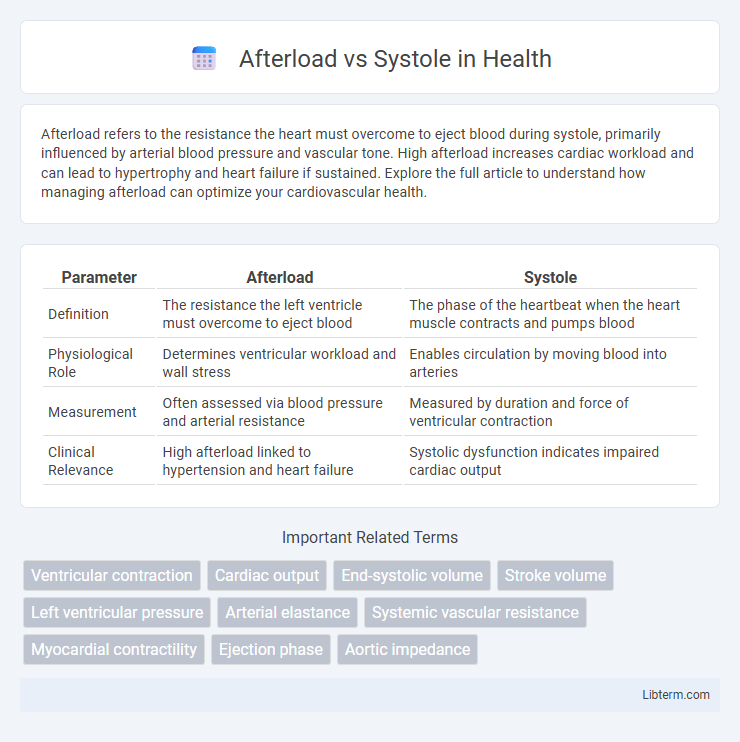Afterload refers to the resistance the heart must overcome to eject blood during systole, primarily influenced by arterial blood pressure and vascular tone. High afterload increases cardiac workload and can lead to hypertrophy and heart failure if sustained. Explore the full article to understand how managing afterload can optimize your cardiovascular health.
Table of Comparison
| Parameter | Afterload | Systole |
|---|---|---|
| Definition | The resistance the left ventricle must overcome to eject blood | The phase of the heartbeat when the heart muscle contracts and pumps blood |
| Physiological Role | Determines ventricular workload and wall stress | Enables circulation by moving blood into arteries |
| Measurement | Often assessed via blood pressure and arterial resistance | Measured by duration and force of ventricular contraction |
| Clinical Relevance | High afterload linked to hypertension and heart failure | Systolic dysfunction indicates impaired cardiac output |
Understanding Afterload: A Key Cardiac Concept
Afterload refers to the resistance the left ventricle must overcome to eject blood during systole, directly influencing cardiac workload and oxygen demand. High afterload, often caused by hypertension or aortic stenosis, increases left ventricular wall stress and can reduce stroke volume. Understanding the interplay between afterload and systole enhances clinical assessment of cardiac function and guides effective treatment strategies in heart failure management.
Defining Systole: The Heart's Contraction Phase
Systole is the phase of the cardiac cycle during which the heart muscle contracts, resulting in the ejection of blood from the ventricles into the aorta and pulmonary artery. Afterload refers to the resistance the ventricles must overcome to eject blood during systole, primarily influenced by arterial pressure and vessel elasticity. Understanding the relationship between afterload and systole is crucial for assessing cardiac function and managing conditions like hypertension and heart failure.
Afterload vs Systole: Core Differences Explained
Afterload refers to the resistance the left ventricle must overcome to eject blood during systole, directly impacting cardiac workload and myocardial oxygen consumption. Systole is the phase of the cardiac cycle when the heart contracts to pump blood into the aorta and pulmonary artery, initiating ventricular ejection. Understanding the core differences between afterload and systole is crucial for managing cardiovascular conditions, as afterload influences systolic performance and overall cardiac output.
How Afterload Influences Systolic Function
Afterload significantly impacts systolic function by determining the resistance the left ventricle must overcome to eject blood during systole. Elevated afterload increases myocardial wall stress, reducing stroke volume and decreasing ejection fraction, which impairs cardiac output. Chronic high afterload can lead to left ventricular hypertrophy as an adaptive response to maintain systolic performance.
Physiological Factors Affecting Afterload
Afterload refers to the resistance the left ventricle must overcome to eject blood during systole, primarily influenced by arterial blood pressure and vascular tone. Increased arterial stiffness or vasoconstriction elevates afterload, making ventricular contraction more forceful and energy-demanding during systole. Key physiological factors affecting afterload include systemic vascular resistance, aortic valve integrity, and arterial compliance.
The Mechanism of Systole in Cardiac Cycle
During systole, the left ventricle contracts, generating pressure that exceeds aortic pressure to open the aortic valve, enabling blood ejection into the systemic circulation. Afterload represents the resistance the ventricle must overcome to eject blood, primarily determined by arterial blood pressure and vascular tone. Elevated afterload increases ventricular workload, potentially reducing stroke volume and influencing systolic duration and efficiency in the cardiac cycle.
Clinical Implications: Afterload and Systolic Performance
Afterload, defined as the resistance the left ventricle must overcome to eject blood, directly impacts systolic performance by influencing stroke volume and cardiac output. Elevated afterload, often seen in hypertension and aortic stenosis, increases myocardial oxygen demand and can lead to left ventricular hypertrophy, reducing systolic efficiency. Optimizing afterload through pharmacologic agents like vasodilators improves systolic performance, highlighting its critical role in managing heart failure and preserving myocardial function.
Measuring Afterload and Systolic Parameters
Afterload is commonly measured using parameters such as systemic vascular resistance (SVR) and arterial blood pressure, which reflect the resistance the left ventricle must overcome during systole. Systolic function is assessed by metrics like ejection fraction (EF), stroke volume, and systolic blood pressure, indicating the heart's pumping efficiency. Accurate simultaneous evaluation of afterload and systolic parameters is essential for diagnosing cardiovascular conditions and optimizing therapeutic interventions.
Common Disorders Affecting Afterload and Systole
Hypertension and aortic stenosis are common disorders that increase afterload, leading to left ventricular hypertrophy and reduced systolic function. In contrast, conditions like dilated cardiomyopathy directly impair systole by decreasing myocardial contractility and stroke volume. Managing these disorders requires targeted therapies to reduce afterload and support systolic performance for optimal cardiac output.
Optimizing Heart Health: Managing Afterload and Systolic Function
Managing afterload effectively reduces the resistance the heart must overcome during systole, enhancing ventricular ejection and cardiac output. Optimizing systolic function involves improving myocardial contractility and minimizing afterload to prevent left ventricular hypertrophy and heart failure. Strategies such as antihypertensive therapy and lifestyle modifications play crucial roles in balancing afterload and systolic performance for optimal heart health.
Afterload Infographic

 libterm.com
libterm.com